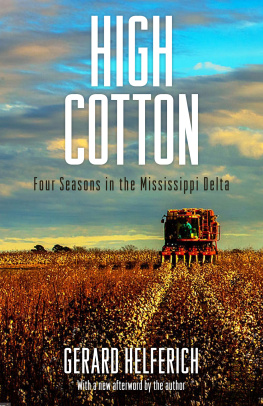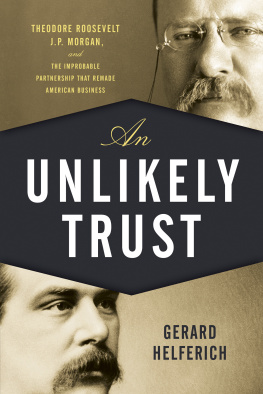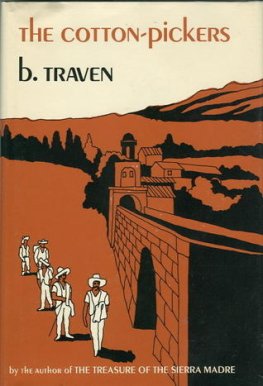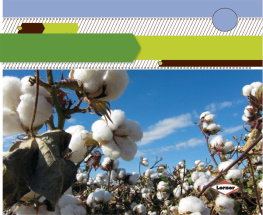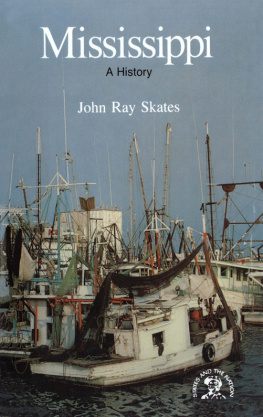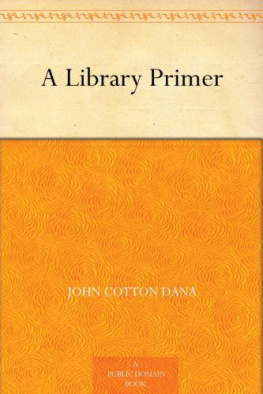
High Cotton
ALSO BY GERARD HELFERICH
Humboldts Cosmos:
Alexander von Humboldt and the Latin American Journey That Changed the Way We See the World
Stone of Kings:
In Search of the Lost Jade of the Maya
Theodore Roosevelt and the Assassin:
Madness, Vengeance, and the Campaign of 1912
An Unlikely Trust:
Theodore Roosevelt, J. P. Morgan, and the Improbable Partnership That Remade American Business
High Cotton
Four Seasons in the Mississippi Delta

GERARD HELFERICH
University Press of Mississippi / Jackson
www.upress.state.ms.us
The University Press of Mississippi is a member of the Association of American University Presses.
Copyright 2007 by Gerard Helferich
Afterword to the new paperback edition 2017 by Gerard Helferich
Originally published 2007 by Counterpoint Press, Berkeley
All rights reserved
First UPM printing 2017
Library of Congress Cataloging-in-Publication Data
Names: Helferich, Gerard, author.
Title: High cotton: four seasons in the Mississippi Delta / Gerard Helferich.
Description: Jackson: University Press of Mississippi, 2017. | Series: Banner Books | Includes bibliographical references and index. |
Identifiers: LCCN 2017024958 (print) | LCCN 2017031412 (ebook) | ISBN 9781496815729 (epub single) | ISBN 9781496815736 (epub institutional) | ISBN 9781496815743 (pdf single) | ISBN 9781496815750 (pdf institutional) I ISBN 9781496815712 (pbk.: alk. paper)
Subjects: LCSH: Delta (Miss.: Region)History. | Delta (Miss.: Region)Biography. | Cotton farmersMississippiDelta (Region)Biography. | Cotton growingMississippiDelta (Region) |
Farm
lifeMississippiDelta (Region) | SeasonsMississippiDelta (Region) | Delta (Miss.: Region)Social life and customs. | Delta (Miss.: Region)Description and travel.
Classification: LCC F347.Y3 (ebook) | LCC F347.Y3 H452 2017 (print) | DDC
976.2/4dc23
LC record available at https://lccn.loc.gov/2017024958
British Library Cataloging-in-Publication Data available
In memory of my parents
William H. Helferich Jr.,
who gave me a love for words,
and
Marion Helferich Rehn,
who gave me the confidence to set down my own.
To understand the world, you have to understand a place like Mississippi.
WILLIAM FAULKNER
Contents
Prologue:
The Most Southern Place on Earth
In the northwest corner of Mississippi, bounded on one side by the baroque coils of its namesake river and on the other by the equally tortuous Yazoo and Tallahatchie, lies the extraordinary diamond of land known simply as the Delta. Beginning roughly at the Tennessee border, the region extends up to seventy miles across and nearly two hundred miles end to end, from Memphis in the north to Vicksburg in the south. Long a land of cultivated fields and muddy sloughs, antebellum mansions and sharecropper shacks, courtly manners and human depravity, the Delta has served as the emblem of an entire region, the most southern place on earth.
Graced (or cursed) with an overwhelming sense of place, the Delta has exerted an influence on the nation out of all proportion to its 7,000 square miles. Its flatness and fertility alone would have ensured its uniqueness. But as cradle of the blues and home to myriad writers, the Delta has stamped not just our culture but that of the world. Even more significant has been the regions long association with cotton. Once the nations greatest producer of the fiber, today Mississippi is second only to the much larger state of Texas. And 80 percent of Mississippis crop is still grown in the rich soil of the Delta, blanketing nearly a million acres and producing fiber valued at almost a billion dollars annually. Though cotton has been raised for thousands of years, from India to Arizona, it is identified with no other region as strongly as here.
So central is the story of the plant to the story of the place that it is impossible to tell one without telling the other. Cotton is the starting point from which the rest of the Deltas narrative flowsthe reason the land was settled, the reason it was peopled with slaves, even why so many African Americans later fled to northern cities such as Chicago and Detroit. The Delta was mostly wilderness in antebellum times, but it was in the areas settled tracts that plantation agriculture, and the system of chattel slavery that supported it, attained its perfect, terrible expression. And for a long century following Emancipation, it was in the Delta that white landowners battled most ferociously to maintain the prerogatives of an earlier, racially unambiguous era, as though the levees built to control the rivers could also hold back waves of social and political change.
Not only did cotton determine the history of the Delta and the South, it shaped the story of the nation. In the antebellum era, the United States was the worlds greatest exporter of the fiberand so it is today, claiming 40 percent of the world market. It was cotton that paid the early Republics bills and cotton that fueled Americas first factories. Without cotton, slavery would not have taken root so deeply in the South, loosing the economic and sectarian tensions that led to civil war. Without cotton, in all likelihood there would have been no Republican Party, no Reconstruction, no battle to reclaim civil rights that had not been self-evident to the Founding Fathers. Absent this single crop, the past two hundred years of American life would have been unimaginably different. Todays racial landscape would be unrecognizable as well, for the enduring rift between black and white is also part of the legacy of cotton.
Even more than the story of an exceptional plant and a singular region that have shaped the history of our country, this book is a chronicle of the people who still risk everything to raise this ancient and essential crop. Zack Killebrew is a small-time operator who, except for a youthful stint on Mississippi riverboats, has lived and farmed in the Delta all his life, as his parents and grandparents did before him. For thirty years, Zack has struggled to raise cotton, sometimes with only his prodigious know-how and Rebel stubbornness to sustain him. The enterprise has altered dramatically, and as we follow Zack through his annual cycle from planting to harvest, we will see that the challenges he faces are very different from those of his forebears. The perennial threat of rising water in the Delta has been all but eliminated by a historic flood-control initiative. With a blizzard of farm programs, the federal government now assumes some of the risk inherent in growing cotton. Sophisticated machinery and potent chemicals perform work once done by human hands. Even the cotton plant itself has been genetically altered to resist insects and herbicides. But perhaps more impressive than all these changes is how little cotton growing has altered in its fundamentals. Government and technology have not eliminated the essential precariousness of the farmers life, which still hinges, as always, on the unreliable weather.
In addition, fierce new economic and political pressures now threaten to accomplish what droughts and floods and weevils could notto drive small farmers like Zack off the land. Every year has become a make-or-break season, and a single bad harvest could be enough to put him out of business, as it already has done many of his neighbors. Every year, more than anything, Zack is fighting for the privilege of starting again the following spring.
Next page
